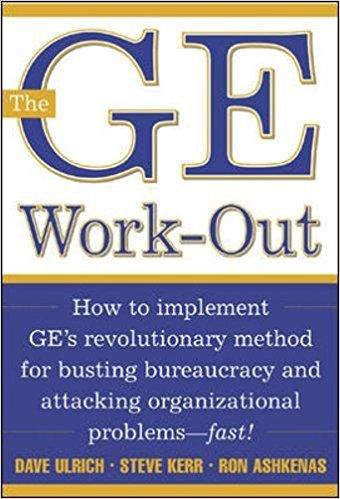The GE Work-Out Summary
5 min read ⌚
 How to Implement GE’s Revolutionary Method for Busting Bureaucracy and Attacking Organizational Problems – Fast!
How to Implement GE’s Revolutionary Method for Busting Bureaucracy and Attacking Organizational Problems – Fast!
In today’s post, we will talk about the Work-Out program which General Electric (GE) used to successfully cut costs, reduce bureaucracy and create a better corporate culture.
Stay with us for the next thousand words, and find out how you can achieve the same.
Who Should Read “The GE Work-Out”? and Why?
It is clear that the Work-Out system is efficient since it helped General Electric immensely. However, many companies still do it wrong.
“The GE Work-Out” is an introductory guide that explains what the Work-Out is, and summarizes the success story of Jack Welch who introduced it in GE.
We recommend this book to all readers who are thinking about embracing change.
About Dave Ulrich, Steve Kerr and Ron Ashkenas
 Dave Ulrich, apart from being an author, also teaches at the University of Michigan School of Business.
Dave Ulrich, apart from being an author, also teaches at the University of Michigan School of Business.
 Steve Kerr, is a former vice president of leadership development and chief learning officer of GE. He is currently head learning officer and managing director of Goldman Sachs.
Steve Kerr, is a former vice president of leadership development and chief learning officer of GE. He is currently head learning officer and managing director of Goldman Sachs.
Ron Ashkenas is an author and a managing partner in the Robert H. Schaffer & Associates consulting firm.
“The GE Work-Out Summary”
During the 80s and 90s, GE was under the governance of CEO Jack Welch, otherwise known as “Neutron Jack.” These were the times when the Work-Out program appeared.
Welch got his nickname because of the ruthless cuts of bureaucracy and levels of management, and his management principles by which GE either had to be the top one company of each market it ever entered or else it stopped doing business in the market.
By the end of his glory days, he had got rid of more than 200 000 people.
The seed of the Work Out idea was rooted during some of the listening sessions he had with GE’s Crotonville development campus.
Listening to the managers talking about the changes that were happening in GE Welch realized that although he decreased the number of administrative levels and had financially improved results, the culture of GE screamed “bureaucracy.”
People were stuck in their comfort zones and were afraid to take risks. They made decisions slowly and carefully. Managers avoided responsibility.
The layoff of so many employees did reduce the costs, but the workload stayed the same, which meant that those that were left working for the company were overburdened by obligations.
At the beginning of the nineties, a group of managers decided to raise the voice and told Jim Baughman, then GE’s director all their problems. He then went to Welch to look for a solution. Their meeting resulted in an agreement: it was crucial to reduce unnecessary tasks, and hence they created the Work-Out.
The Work-Out had a strange start. On the one hand, it was mandatory, since all were required to participate, and on the other hand it was voluntary since no one could make someone tell the truth. So, if people wanted to give you their actual opinion – they had to decide to do that themselves.
The first thing the program required was for the business leaders to do cross-level, cross-functional meetings, in which people would state their worries.
As expected, the feelings and thoughts that employees had after seeing many of their friends fired and the informal networks destroyed, were full of mistrust, suspicion, and resentment.
Moreover, they did not think that the Work-Out could help. They believed it was just another program that would make things harder for them. They could not believe that the talk of empowerment and teamwork is honest.
However, as time went by, the employees started participating in the brainstorming sessions and began giving their suggestions.
The brainstorming was on factors that limited progress, and on easy cost reductions which could be achieved by eliminating bureaucratic bottlenecks and unnecessary tasks.
However, those were only the early stages. Soon Welch was finding ways to use the Work-Out more creatively. He pushed for making the three operating values “speed, simplicity and self-confidence” a fact, instead of wishful thinking.
Overall, the Work-Out makes people do things they would not do, like, for example, making decisions. People avoid being in a situation in which they have to make a decision since choices come with a portion of the risk.
The Work-Out forces people to stand in the center of a room and make a decision, learning to live with the intimidation that comes with the risk. It also makes things faster, and more efficient.
To implement the Work-Out successfully, everyone in your company must be involved.
Usually, people will not want to Work-Out, since their comfort zones are much more comfortable than change. They will come up with a few objections, but you need to be persistent and patient enough to explain what the Work-Out involves, and let them see the results themselves.
You can do this by creating a simple one-day Work-Out, at any level, as a trial run.
Then, when it comes to the actual full Work-Out take your time with the preparation and presentation.
The most important thing to remember is that change is scary until it becomes a routine.
Key Lessons from “The GE Work-Out”:
1. Stretch
2. Systems Thinking
3. Lateral Thinking
4. Empowerment and Accountability
5. Fast Decisions
Stretch
Push yourself. Set higher goals than your mind lets you believe is reasonable. Stretch as much as you can.
Systems Thinking
Teach your employees to look at the entire process instead of just the endpoint. Saving costs is great, but maybe the thing you are trying to eliminate to achieve that is indispensable in some other unit of the company. Look at the whole picture and not its separate pieces.
Lateral Thinking
Brainstorm. There is no such thing as a stupid or weird idea. Create a culture of sharing suggestions and opinions.
Empowerment and Accountability
Let people lead. Put them in charge. Ideas are not enough – you need results. So let people not only make suggestions but make their ideas happen.
Fast Decisions
Speed is essential. Fast decisions mean fast action.
Like this summary? We’d Like to invite you to download our free 12 min app, for more amazing summaries and audiobooks.
“The GE Work-Out” Quotes
One of the ways we’ll know that Work-Out has been successful is that my style of leadership will no longer be tolerated in this company. Share on X Speed is better than perfection. Make it clear what the expectations are – even if they are aspirations that are not yet achieved. Share on X Whether you’re building a house or organizing a Work-Out session, you need good plans. Share on X As with any change process, the best way to understand Work-Out is to dive in and do it, rather than just talk about it. Share on X Left to themselves, Work-Out groups have a tendency to combine too many ideas that are similar – but not identical – into one. Share on XOur Critical Review
“The GE Work-Out” is a well-organized book which proves its clear points and conveys its messages, making it possible for anyone to implement the Work Out in just about any organization.
However, you should bear in mind that what you will find in this book are tips, but it fails to truly warn you against the commitment that is implementing the Work-Out demands.
Emir is the Head of Marketing at 12min. In his spare time, he loves to meditate and play soccer.


 How to Implement GE’s Revolutionary Method for Busting Bureaucracy and Attacking Organizational Problems – Fast!
How to Implement GE’s Revolutionary Method for Busting Bureaucracy and Attacking Organizational Problems – Fast!




